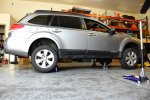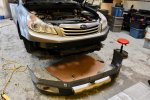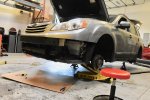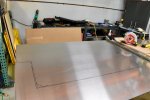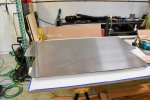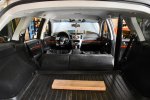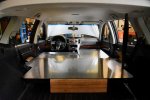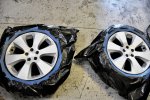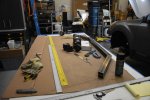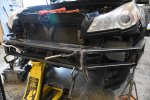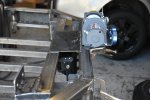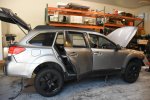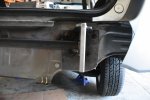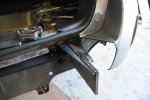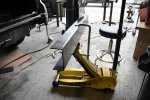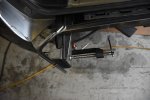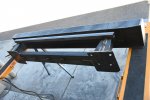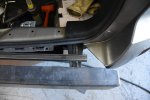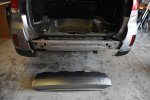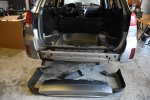Hello everyone!
This thread is the story of my project to outfit my vehicle for overland travel. I am a
senior at University of Pittsburgh studying Material Science Engineering.
This story started out with a bed liner-painted 2000 Jeep Cherokee.

My plans were to lift, new shocks, tire carrier, roof rack, sleeping platform in the back and customized
bumpers that incorporated a winch and LED light bar. The goal was to take my car across the country this
summer and have the ability to handle some backcountry car camping.
6 months after I completed the bed liner project I got in a car accident and Stokely the Jeep was totaled.
This is where the 2011 Subaru Outback, Stokely the Subaru, comes in.

I went back and forth about whether it would be worth it to continue my project on a vehicle such as that or
if it would be practical. I came to the realization that it didn’t matter to me what the car was, what
mattered was that I complete my project and gain knowledge in the process. I am more interested in
learning and doing something fun rather than limiting myself. The worst that could happen is that I end
up with a ************ vehicle to take me on ************ adventures. After all, we all like to be ************.
Enough of the jibber-jabber, here’s what we are working on.
Project Outline
Strut Spacers:
Initially I researched Subaru Outback builds and came up with only a handful of people who had tried something similar so I sought the help of my good friend David, who is a complete genius when it comes to projects like this. He has a mechanical engineering background and years of innovation in several different industries, I was positive we would be able to pull this off. With that said a lot of the products that I chose for this build were grounded in recommendations from David.
We just finished up our second day of 10 and so far we have the sleeping platform panels cut to size and are ready to start the fab work for the front bumper. I will be posting plenty of photos as the build continues. I hope you all enjoy the story of our experience and the insight we gained from this.
This thread is the story of my project to outfit my vehicle for overland travel. I am a
senior at University of Pittsburgh studying Material Science Engineering.
This story started out with a bed liner-painted 2000 Jeep Cherokee.

My plans were to lift, new shocks, tire carrier, roof rack, sleeping platform in the back and customized
bumpers that incorporated a winch and LED light bar. The goal was to take my car across the country this
summer and have the ability to handle some backcountry car camping.
6 months after I completed the bed liner project I got in a car accident and Stokely the Jeep was totaled.
This is where the 2011 Subaru Outback, Stokely the Subaru, comes in.

I went back and forth about whether it would be worth it to continue my project on a vehicle such as that or
if it would be practical. I came to the realization that it didn’t matter to me what the car was, what
mattered was that I complete my project and gain knowledge in the process. I am more interested in
learning and doing something fun rather than limiting myself. The worst that could happen is that I end
up with a ************ vehicle to take me on ************ adventures. After all, we all like to be ************.
Enough of the jibber-jabber, here’s what we are working on.
Project Outline
Strut Spacers:
- Anderson Design & Fabrication
- https://andersondesign-fab.com/product/2010-2014-forester-2-strut-spacers-w-multi-link-spacers/
- $624.99
- Terra 45 Superwinch
- 4500 lbs. w/ steel cable
- https://www.etrailer.com/Electric-Winch/Superwinch/SW1135220.html
- $225
- Synthetic Line- $47.99
- https://www.amazon.com/dp/B0721K6CT...d_rd_r=N0R567NPZX7KKFCKJ0HB&pd_rd_w=HPSVe
- KYB Excel G
- http://www.shockwarehouse.com/index...=4451&selected_year=2011&mode=results
- $268.62
- 12”
- Reused from my Jeep
- Purchased from Tractor Supply
- This is a nice tool to figure out what’s best for you
- Details to come
- Fabricated using steel tubing and Aluminum plates
- More details to come
- Details to come
- Details to come
- Details to come
- Aluminum plates
- Fabricated from econolite panels
- Pictures to come
Initially I researched Subaru Outback builds and came up with only a handful of people who had tried something similar so I sought the help of my good friend David, who is a complete genius when it comes to projects like this. He has a mechanical engineering background and years of innovation in several different industries, I was positive we would be able to pull this off. With that said a lot of the products that I chose for this build were grounded in recommendations from David.
We just finished up our second day of 10 and so far we have the sleeping platform panels cut to size and are ready to start the fab work for the front bumper. I will be posting plenty of photos as the build continues. I hope you all enjoy the story of our experience and the insight we gained from this.

